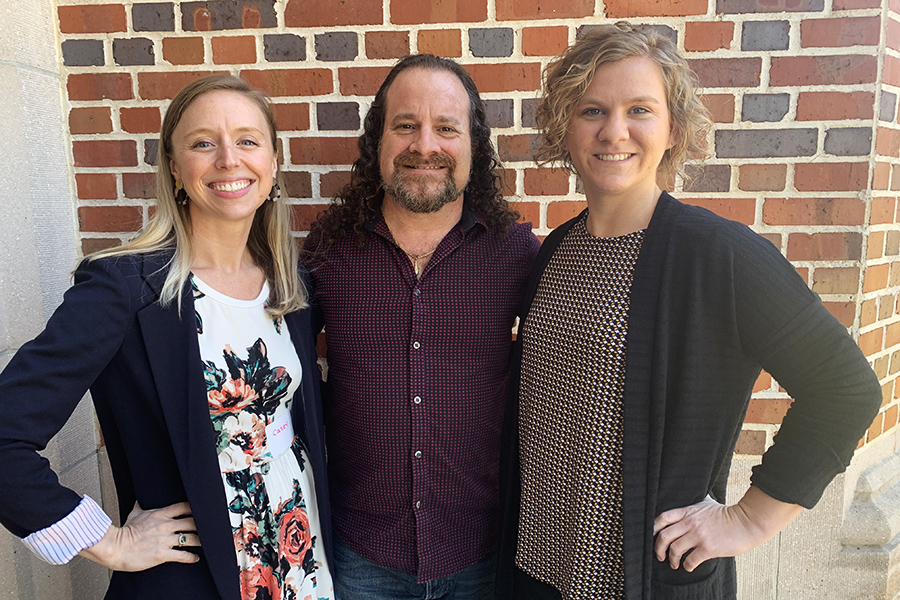
The Florida State University Art Therapy program and the Florida Department of Corrections are partnering up with the goal of providing young adult inmates alternate paths to receiving their General Education Degrees (GED) while addressing their various mental health, emotional and behavioral challenges.
Launched earlier this year, the first–of–its–kind Art Therapy in Prisons Program is a collaborative effort funded through an Individuals with Disabilities Education Act (IDEA) multi–year grant that will deliver art therapy services to young offenders for at least the next three years.
Dave Gussak, a professor for the Graduate Art Therapy Program in the Department of Art Education, has been involved in bringing art therapy into correctional settings for almost 30 years, and FSU’s graduate art therapy practicum students have had the opportunity to complete their internships in these settings for the past 15 years.
“This one-of-a-kind program has hired art therapists to provide these services full time,” Gussak said. “While there are art therapists in correctional systems throughout the U.S. and around the world, this is the first program that I know of where there is a direct collaboration between a university and state department of corrections to formalize and clearly define the work and the scope of art therapists within these systems. To me, this is the gratifying culmination of almost 30 years of work.”
Since arriving at FSU in 2002, Gussak has conducted research studies in several Florida correctional institutions, established art therapy practicum placements in multiple correctional settings in North Florida and has been asked to consult with various art therapists and art facilitators in correctional settings across the United States and around the world.
Jerry Brown, program manager for the Florida Department of Corrections educational system, and Gussak have worked closely together for over two years developing this initiative. The contract between the two entities was signed in December 2019 and is the first of its kind in the U.S.
Shortly after the program was implemented, the effects of COVID-19 and social distancing requirements made it difficult to provide face-to-face services, but the team continues to develop unique methods to provide art therapy to isolated inmates.
“I have seen people come alive with the creative process. They are given a safe space for self-expression and met, often for the first time, without judgment. I have seen inmates who had given up on themselves uncover a new passion and desire for personal transformation.”
— Casey Barlow
Gussak serves as project coordinator and art therapists Casey Barlow and Evie Soape — both FSU graduates — were hired by the FSU Department of Art Education to provide services to young offenders in three men’s prisons and one women’s prison.
Barlow serves the male and female inmates in Lowell and Marion Correctional Institutions near Ocala, Florida. Soape provides art therapy to the youthful offenders housed in Suwannee and Columbia Correctional Institutions in and near Lake City, Florida.
There are currently programs in place within the prison system that provide inmates with the opportunity to further pursue their education and earn a GED. However, inmates face many obstacles, such as intellectual challenges and behavioral and emotional difficulties. Many also suffer from traumatic brain injuries and mental illness, which hinder learning capabilities.
“People who are incarcerated often have extensive histories of trauma,” Barlow said. “I, wish to create a positive impact to spread a message that everyone is deserving of compassion and empathy, and that no one should be defined by their greatest mistakes, which are usually summations of a lifetime of traumatic experiences.”
Through research, art therapy has been found to be especially beneficial with prison populations as it builds upon the inmates’ natural tendency to create. It is effective in addressing various mental illnesses and increasing an individual’s ability to regulate control and facilitate anger management. It has also been found to be helpful in promoting problem-solving, socialization and identity formation. In addition, art therapy aids in mitigating neurological struggles due to brain injury, substance abuse and intellectual challenges.
Soape’s plan is to bring art therapy to the prison population as a catalyst for exploring these concepts and to empower individuals impacted by incarceration to make the invisible visible through creative expression.
“In my experience, the process of art making encourages self-exploration and discovery, improves problem-solving and decision-making skills and increases self-efficacy and self-esteem,” Soape said. “My hope is that the Art Therapy in Prisons Program will provide these and many more benefits to this population and give a voice to those unseen and unheard due to incarceration.”
The new program provides weekly individual and group art therapy services, while Gussak, Soape and Barlow conduct ongoing research to determine the program’s effectiveness in meeting the intended outcomes.
Now, despite COVID-19, the team has been successful in maintaining indirect contact with inmates while offering support through art therapy. In addition, they are considering alternative ways of using technology to provide these services while adhering to the limitations inherent within the correctional system.
“We’ve been able to adapt and expand our therapeutic focus to address additional stress, anxiety, fear and confusion those incarcerated are facing during these uncertain times,” Gussak said.
Art therapy provides the client with the extraordinary opportunity to view their artwork, which is an externalized extension of their inner self. With the therapist’s support, this interaction encourages the client to honestly explore themselves and reflect on his or her process of creating.
“Over the past few years that I have been working in corrections, I have seen people come alive with the creative process,” Barlow said. “They are given a safe space for self-expression and met, often for the first time, without judgment. I have seen inmates who had given up on themselves uncover a new passion and desire for personal transformation.”
The team is hoping to grow the program and add more art therapists in prisons throughout the state in the coming years.




